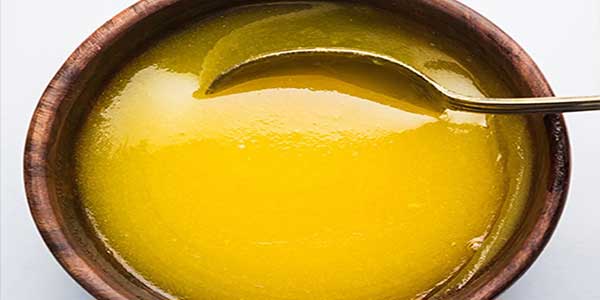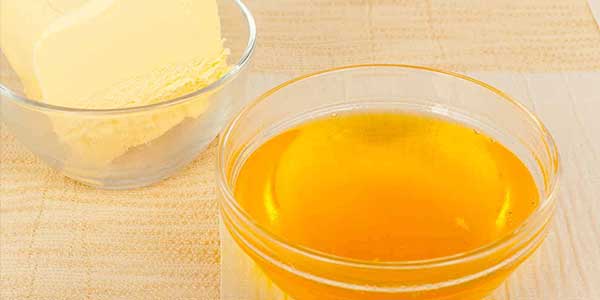Introduction:
Clarified butter, also known as ghee, is a staple ingredient in many cuisines around the world. It is a type of butter that has been simmered to remove impurities, resulting in a pure golden liquid with a rich, nutty flavor. Ghee is widely used in Indian, Middle Eastern, and South Asian cooking, and it has gained popularity in other culinary traditions as well. In this comprehensive article, we will explore the uses, qualities, origin, sources, applications, health benefits, culinary uses, how to use clarified butter in cooking, and potential side effects associated with its consumption.
Origin and Sources of Clarified Butter (Ghee):
Ghee has a long history and can be traced back to ancient times. It originated in the Indian subcontinent, where it has been a traditional cooking ingredient for thousands of years. In Indian culture, ghee holds a significant place, both in culinary practices and religious rituals. Traditionally, ghee was made from cow’s milk, but it can also be made from the milk of other animals, such as buffalo or sheep. Today, ghee is produced worldwide and is readily available in most supermarkets and specialty stores.
Production of Clarified Butter (Ghee):
The production of clarified butter involves a simple process of separating the milk solids and water from butterfat. Here’s a step-by-step guide to making ghee:
a) Start with unsalted butter: Unsalted butter is used to make ghee as it allows for better control of the final flavor and removes the need to adjust the salt content in recipes.
b) Melt the butter: Place the butter in a heavy-bottomed saucepan and melt it over low heat. Allow it to simmer gently.
c) Skim off the foam: As the butter melts, foam will begin to form on the surface. Skim off the foam using a spoon or ladle. This foam consists of milk solids and impurities.
d) Simmer and clarify: Continue simmering the butter over low heat until it clarifies. During this process, the water content will evaporate, and the milk solids will settle at the bottom of the pan.
e) Strain and store: Once the butter has clarified and turned golden in color, strain it through a fine-mesh sieve or cheesecloth to remove any remaining milk solids. The resulting liquid is clarified butter or ghee. Store it in a clean, airtight container at room temperature.

Qualities of Clarified Butter (Ghee):
Clarified butter, or ghee, possesses several qualities that make it a preferred cooking ingredient. Here are some notable qualities:
a) High Smoke Point: Ghee has a high smoke point, typically around 450°F (232°C), which means it can withstand high heat without breaking down and producing smoke or harmful compounds. This makes it suitable for various cooking methods, including frying, sautéing, and deep-frying.
b) Rich Nutty Flavor: Ghee has a distinct, rich, and nutty flavor. The process of clarifying the butter enhances its natural taste, giving it a unique aroma and depth of flavor.
c) Long Shelf Life: Ghee has a long shelf life due to its low moisture and absence of milk solids. When stored properly in an airtight container, ghee can last for several months without refrigeration.
d) Lactose and Casein-Free: The clarifying process removes the milk solids, including lactose and casein, making ghee suitable for individuals with lactose intolerance or dairy sensitivities. However, those with severe allergies should exercise caution and consult with a healthcare professional.
e) Nutritional Profile: Ghee is rich in fat-soluble vitamins, such as vitamins A, D, E, and K. It also contains healthy saturated fats, omega-3 fatty acids, and conjugated linoleic acid (CLA), which may offer various health benefits.
Uses and Applications of Clarified Butter (Ghee):
Clarified butter, or ghee, is a versatile ingredient that finds numerous applications in cooking, baking, and beyond. Let’s explore some of its primary uses:
a) Cooking: Ghee is widely used for sautéing, stir-frying, and deep-frying due to its high smoke point. It adds a rich, nutty flavor to dishes and imparts a unique aroma that enhances the overall taste.
b) Baking: Ghee can be used as a substitute for butter or oil in baking recipes. It lends a distinct flavor and can contribute to the texture and moisture of baked goods.
c) Flavoring Agent: Ghee is often drizzled over cooked dishes or added as a finishing touch to enhance their flavor. It can be used as a spread on bread, added to rice, or incorporated into sauces and gravies.
d) Traditional Medicine and Ayurveda: Ghee has been used for centuries in Ayurvedic medicine for its therapeutic properties. It is believed to improve digestion, nourish the body, and promote overall well-being.
e) Rituals and Ceremonies: Ghee holds religious and cultural significance in many traditions. It is commonly used in Hindu rituals, ceremonies, and as an offering to deities.

Health Benefits of Clarified Butter (Ghee):
Clarified butter, or ghee, offers several potential health benefits when consumed in moderation. Here are some of the notable benefits:
a) Rich in Nutrients: Ghee contains fat-soluble vitamins, including vitamins A, D, E, and K, which play crucial roles in various bodily functions. These vitamins support vision, bone health, immune function, and overall well-being.
b) Healthy Fats: Ghee is predominantly composed of saturated fats, which are essential for the body’s energy production, hormone synthesis, and brain function. The presence of healthy saturated fats in ghee can help improve cholesterol levels and promote cardiovascular health when consumed as part of a balanced diet.
c) Potential Anti-inflammatory Properties: Ghee contains butyric acid, a short-chain fatty acid with anti-inflammatory properties. This compound may help reduce inflammation in the body and support gut health.
d) Supports Digestion: Ghee is believed to improve digestion and promote the absorption of nutrients. It can help soothe the digestive tract and alleviate symptoms of digestive disorders.
e) Skin and Hair Health: Ghee can be applied topically or consumed internally to promote healthy skin and hair. Its moisturizing properties can help nourish the skin, reduce dryness, and enhance hair luster and strength.
Use of Clarified Butter (Ghee) in Cooking:
Clarified butter, or ghee, is a versatile ingredient in cooking and culinary preparations. Here are some ways to incorporate it into your recipes:
a) Sautéing and Frying: Ghee’s high smoke point makes it ideal for sautéing vegetables, frying meats, or creating flavorful stir-fries. Its rich flavor adds depth and enhances the taste of the cooked dishes.
b) Flavor Enhancer: Use ghee as a finishing touch to drizzle over cooked dishes, such as roasted vegetables, grains, or steamed fish. It adds a rich, buttery flavor and imparts a delightful aroma.
c) Baking Substitute: Replace butter or oil with ghee in baking recipes to add a unique nutty flavor. It works well in cookies, cakes, bread, and pastry dough.
d) Traditional Dishes: Ghee is an essential ingredient in many traditional Indian, Middle Eastern, and South Asian dishes. It adds richness and authenticity to curries, biryanis, lentil dishes, and desserts like halwa or gulab jamun.
e) Coffee or Tea Additive: Add a small amount of ghee to your coffee or tea for a creamy and rich flavor. This is particularly popular in certain coffee traditions, such as Bulletproof coffee.
How to Use Clarified Butter (Ghee):
Using clarified butter, or ghee, in your cooking is straightforward. Here are some tips to help you use ghee effectively:
a) Melting: Ghee is solid at room temperature but melts quickly when heated. Use low to medium heat when melting ghee in a pan or microwave. It will transform into a clear liquid.
b) Substitution Ratio: When replacing other fats with ghee, the general rule of thumb is to use an equal amount of ghee as you would butter or oil in a recipe. However, you may need to adjust based on personal preference and the specific recipe.
c) Storage: Ghee does not require refrigeration and can be stored at room temperature in a cool, dry place. Use an airtight container to protect it from moisture and light, which can cause rancidity.
d) Shelf Life: When stored properly, ghee can last for several months without refrigeration. However, check for any signs of spoilage, such as an off smell or mold growth, before using.
e) Topical Application: Ghee can also be used topically for its moisturizing and nourishing properties. Apply a small amount to dry skin or hair for hydration and to promote overall health.
Side Effects and Precautions:
While clarified butter, or ghee, is generally well-tolerated, it is essential to be mindful of potential side effects and exercise moderation. Here are some precautions to consider:
a) High in Calories: Ghee is calorie-dense due to its high fat content. Overconsumption can contribute to weight gain and associated health issues. It is advisable to incorporate ghee into a balanced diet and control portion sizes.
b) Individual Sensitivities: Some individuals may be allergic or intolerant to dairy products, including ghee. If you have a known dairy allergy or sensitivity, it is best to avoid ghee or consult with a healthcare professional.
c) Moderation: While ghee offers potential health benefits, excessive consumption may negate its positive effects. It is recommended to use ghee in moderation and as part of a well-rounded diet.
d) Cholesterol Levels: Ghee is rich in saturated fats, which can raise cholesterol levels in some individuals. If you have high cholesterol or a history of heart disease, it is advisable to moderate your intake and consult a healthcare professional.
e) Quality and Purity: When purchasing ghee, opt for high-quality brands or consider making your own to ensure purity and avoid additives or preservatives.
Conclusion:
Clarified butter, or ghee, is a versatile and flavorful ingredient that has been used in traditional cooking for centuries. With its rich, nutty taste, high smoke point, and various health benefits, ghee adds depth and authenticity to dishes. From sautéing and frying to baking and flavor enhancement, ghee finds its place in diverse culinary applications. However, it is essential to consume ghee in moderation, be aware of individual sensitivities or allergies, and consider personal health conditions. When used mindfully, clarified butter can be enjoyed as a delicious and nutritious addition to your culinary repertoire.